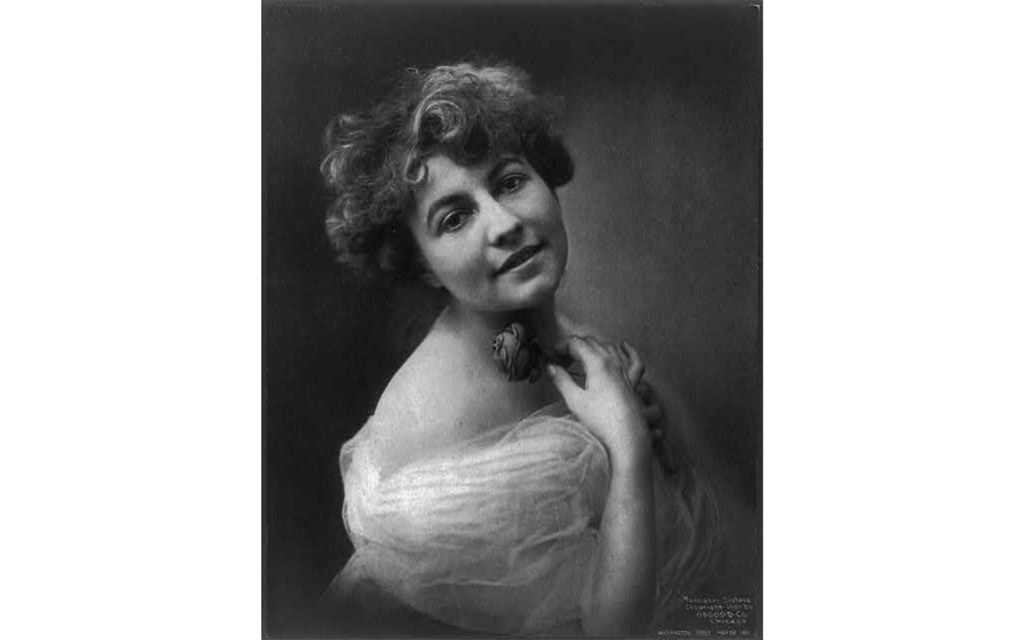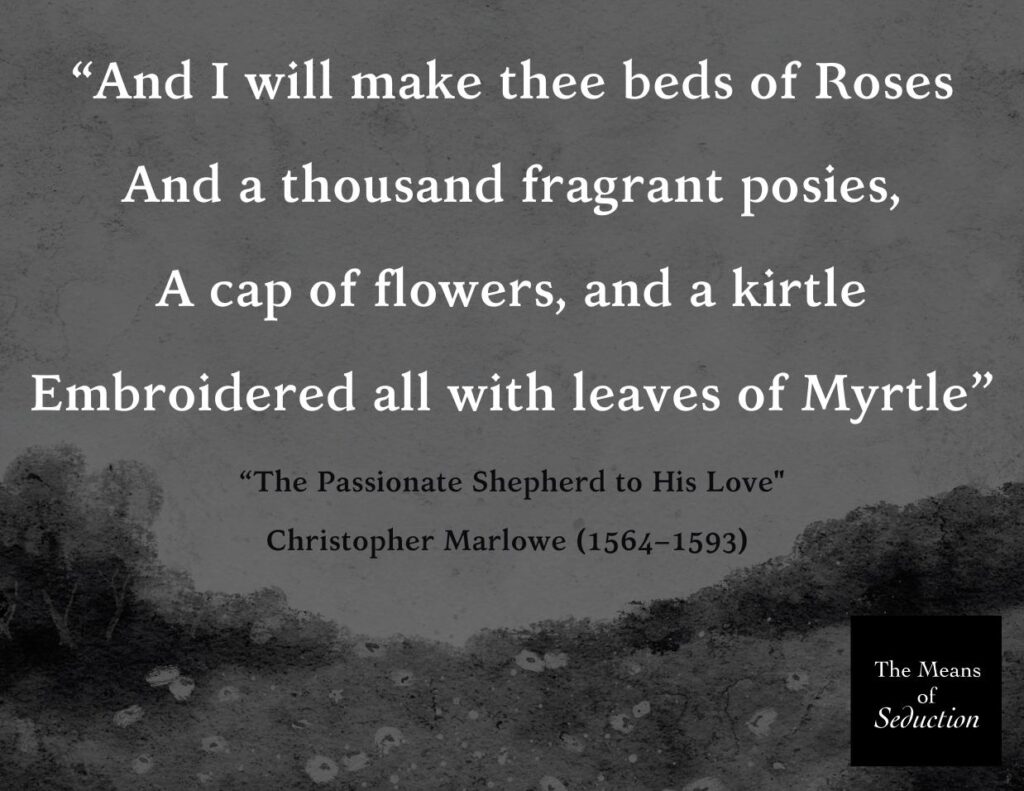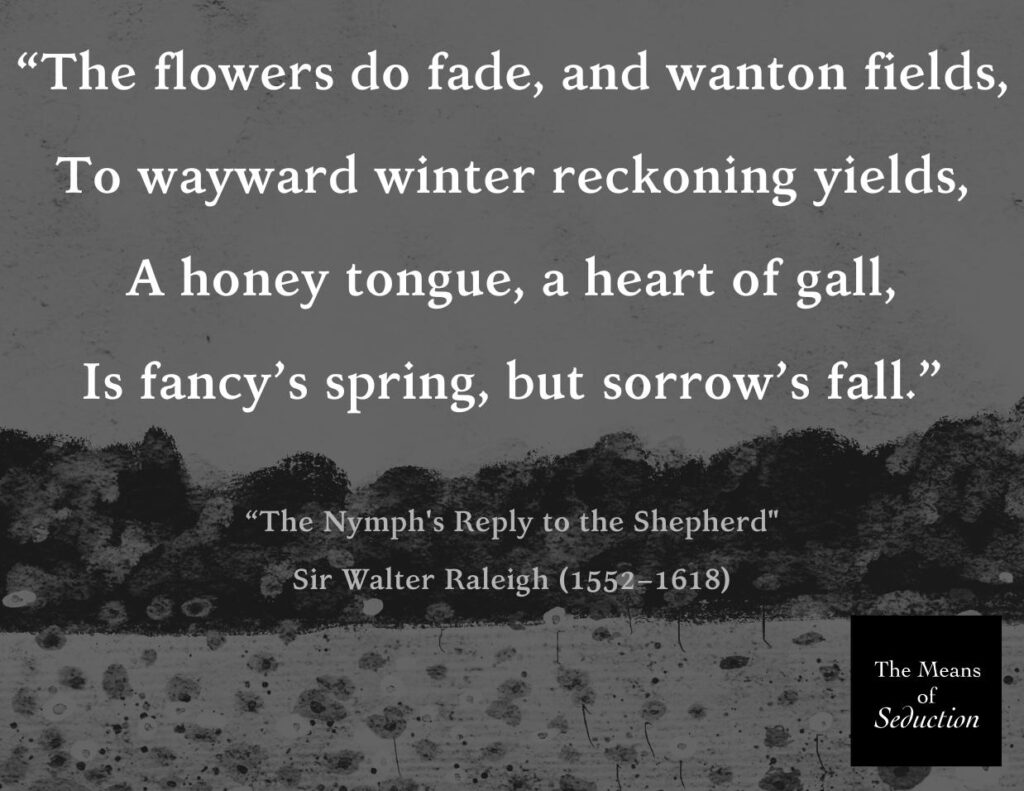Seduction in Renaissance Poetry
Hail, fellow seducers and targets! While I often steer readers of The Means of Seduction towards studying classical film depictions of seduction, today, I will instead route us through a brief course in Renaissance poetry. Indulge me, pray, for I am something of a Renaissance woman. It was only natural that we end up here someday. Let’s explore how seduction in Renaissance poetry portrays seducers and targets through the successful and failed attempts of seduction, persuasion, and manipulation.
The Renaissance
Before we begin, a history refresher is appropriate. The Renaissance – a cultural, artistic, political, and economic “rebirth” in 14th-17th century Europe – unfolded across various countries at different times. Italy pioneered the Renaissance movement as early as the 14th century with a revival of classical Greek learning, but it didn’t reach England until the 16th century. Historians generally agree that the Renaissance had concluded by the early 17th century. Spanning from approximately 1450 to 1650, the Renaissance era witnessed European exploration of nearly every continent, excluding Antarctica. Several pivotal events catalyzed the emergence of the Renaissance, including the fall of Constantinople to the Ottoman Turks in 1453 which signaled the end of the Byzantine Empire, and the discovery of the New World in 1492 which marked the dawn of an age of exploration. Alongside the significant impact of the Protestant Reformation, Johannes Gutenberg’s invention of the printing press around 1440 facilitated the dissemination of knowledge and ideas.
The Role of Renaissance Poetry
Poetry, as a literary form rooted in classical traditions, inspired a cultural reawakening. Poetry became a crucial part of the cultural revival, due to fortunate courtly patronages of wealthy individuals, including royalty, who financially supported artists. Renaissance poetry often presented political commentaries that challenged social injustices and delved into moral dilemmas while simultaneously offering poets a vehicle for their emotional expression and humanism. Humanism, originating in Italy and spreading across Western Europe during the 14th-16th centuries, was an intellectual movement marked by a renewed fascination with the classical world. It prioritized the study of human nature and the exploration of what it means to be human, shifting focus away from religious doctrines to embrace the importance of humanity and its potential for intellectual, artistic, and moral development. Renaissance poetry explored subjects of mythology and classical literature, nature, religion, and politics as well as love and romance. Through their explorations of these subjects, Renaissance poets often described and incorporated elements of seduction and manipulation.

How Poets Explored Seduction in Renaissance Poetry
- Persuasive Rhetoric: Renaissance poets were masters of language and rhetoric, using their artistic skills to seduce readers with the power of words. Through the skillful manipulation of poetic devices such as rhyme, meter, and imagery, poets crafted verses that resonated deeply with audiences, eliciting strong emotional responses. Seducers themselves often emulate the rhyme and meter of poets, although more inconspicuously, through their speaking cadences.
- Subtlety & Concealed Desire: Renaissance poetry frequently employed subtle gestures and coded language to convey hidden desires. Poets utilized metaphors, innuendos, and euphemisms to allude to romantic intentions without being overtly explicit.
- Sensual Imagery & Erotic Symbolism: Sensuality was a prominent theme in Renaissance poetry, with poets using vivid imagery and erotic symbolism often. Poets created immersive experiences through descriptions of landscapes, natural phenomena, and bodily sensations to evoke feelings of passion and longing.
- Idealization & Courtly Love: Renaissance poets often idealized the object of their affection, portraying them as ethereal beings worthy and requiring of their adoration. Through elaborate descriptions and extravagant praises, poets also sought to evoke feelings of admiration and desire for their readers.
- Intimacy & Emotional Expression: Renaissance poets hardly shied away from revealing their innermost thoughts and feelings in their verses. Instead, baring their souls through their poetry, Renaissance poets explored themes of emotional vulnerability and intimacy with an understanding that transcended physical attraction.
Seducers & Targets in Renaissance Poetry
Analysis & Application of Seduction in Renaissance Poetry: Comparing Christopher Marlowe & Sir Walter Raleigh
Let’s take a look at two Renaissance poems, “The Passionate Shepherd to His Love” by Christopher Marlowe (1564–1593) and “The Nymph’s Reply to the Shepherd” by Sir Walter Raleigh (1552–1618), to compare the ways they present seduction. One is an example of successful seduction (perhaps only by omission of the target’s perspective) and the other is an example of a failed seduction (but “failed” only if the lessons from the target’s perspective are ignored).

“The Passionate Shepherd to His Love” by Christopher Marlowe (excerpt above) is a pastoral poem about a shepherd (seducer) promising idyllic pleasures to his beloved (target).
Written as a response to Marlowe’s poem, Sir Walter Raleigh’s “The Nymph’s Reply to the Shepherd” (excerpt below) presents a skeptical nymph’s rejection (unsuccessful target) of the shepherd (failed seducer).

What can be learned about seducers and targets from these two Renaissance poems?
Well, in both poems, we can observe elements of persuasion, manipulation, resistance, and seduction in the dynamics between the characters. We can see in each poem what a seducer looks like (or is expected to look like) and what a target looks like (or is assumed to look like). We also see how a potential target might respond if they are privy to a seducer’s advances. In Marlowe’s poem, we are shown his side, the elegant and presumably successful side of courtship and seduction. However, in Raleigh’s poem, we hear the perspective of the target and quickly realize Marlowe’s seducer failed whether by a lack of covertness and stealth or by a lack of accurately reading the energy and dynamic between the two.
Seducers know that “love bombing” works only when targets are unaware of its practice. “Sweet nothings”, hasty promises, excessive compliments, and a showering of gifts can conceal manipulation under the guise of romance if performed slowly and under the direct guidance of the target’s wants, needs, fears, and reservations. Seducers know it is often necessary to regroup and strategize new approaches as a target adapts to their attempts. Seducers sense changes in the energy (i.e., mood, emotional response) of their targets and know when dynamics are shifting too far from the intended position. Raleigh’s poem does an excellent job illustrating the tension between the seducer’s efforts to manipulate and the target’s determination to maintain autonomy.
What can be learned about seduction from these two Renaissance poems?
When a target is not responsive to this type of relentless romantic pursuit, a seducer needs to pull back and reassess what it is that the target is actually offended by and concerned about. For example, if a target is disinterested in a seducer’s readiness, availability, and overt displays of desire and longing, then perhaps the seducer needs to withdraw, appear unbothered, and present no urgency towards the target. Some targets want to be pursued, and some targets want to pursue. When targets feel that they are pursuing someone of their own volition, they confuse it with agency and uninformed influence. Seducers benefit from, at times, laying low. Beckoning with absence, seducers allow some targets to lead themselves directly into the seducer’s web all on their own.
Conclusion
Renaissance poetry offers a fascinating glimpse into the complexities of human relationships and the dynamics of courtship during a pivotal period in world history. Through the examination of two contrasting poems, Christopher Marlowe’s “The Passionate Shepherd to His Love” and Sir Walter Raleigh’s “The Nymph’s Reply to the Shepherd,” we gain valuable insights into the multifaceted nature of seduction and the interplay between persuasion, resistance, and manipulation.
We see Marlowe’s seducer embody idealism, and Raleigh’s seducer embody realism. Through these contrasting perspectives, we learn what the seducer sees and what the target sees. Understanding what targets are seeing and feeling is essential to successful seduction, as a seducer will need to tailor his or her approach as the process continues and failing to do will leave a poor impression on the target. Perhaps, for some, reading Renaissance poetry will help them properly identify what seductive attempts look like. Identifying seducers is critical to preventing yourself from becoming a target, and knowing how seduction looks from the receiving end can help you become a better seducer too.
Renaissance poetry, in general, offers a nuanced understanding of human nature and the intricacies of love and desire. What seduction in Renaissance poetry can teach us today is just as relevant as it was when it was first written.
Fare-thee-anon…
